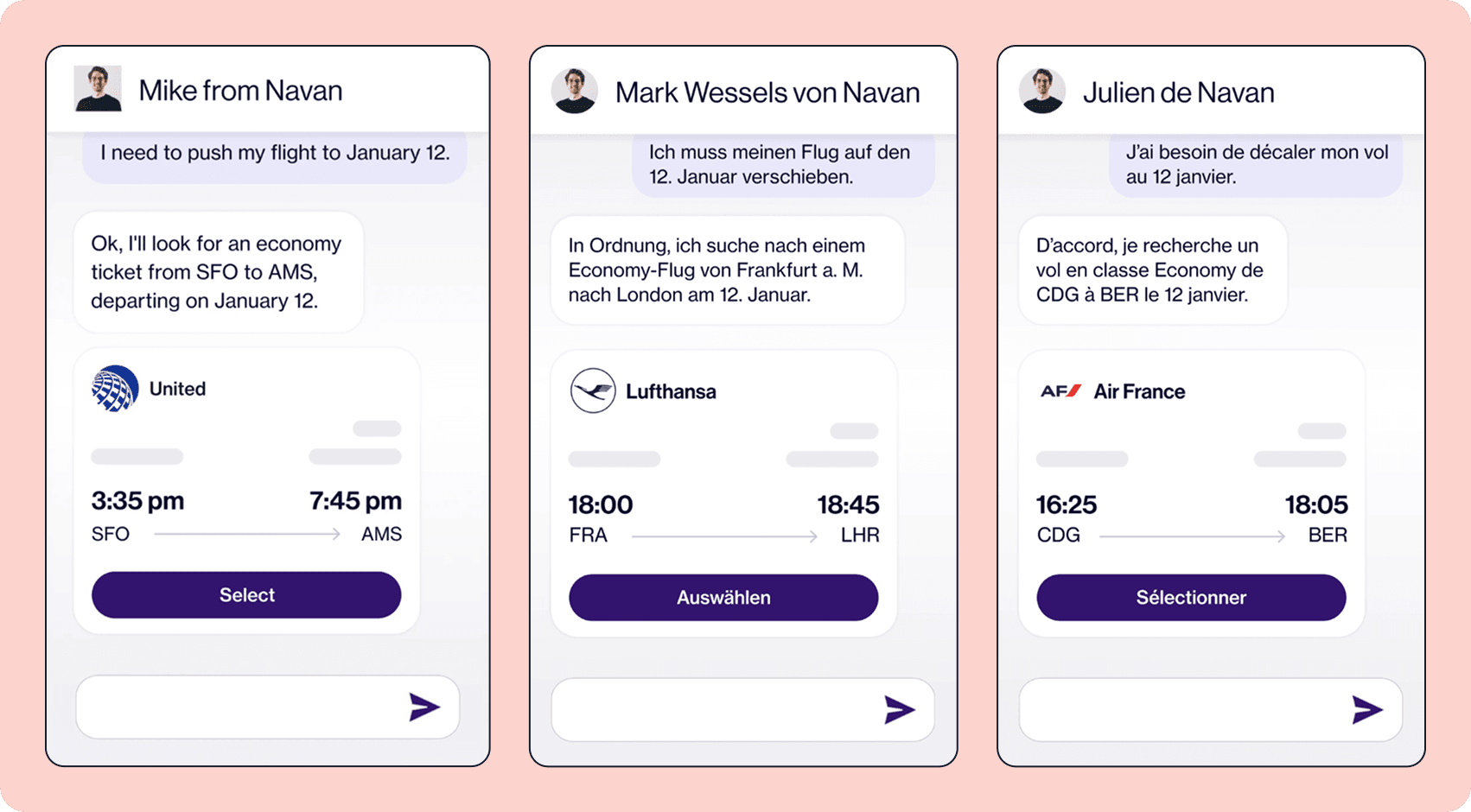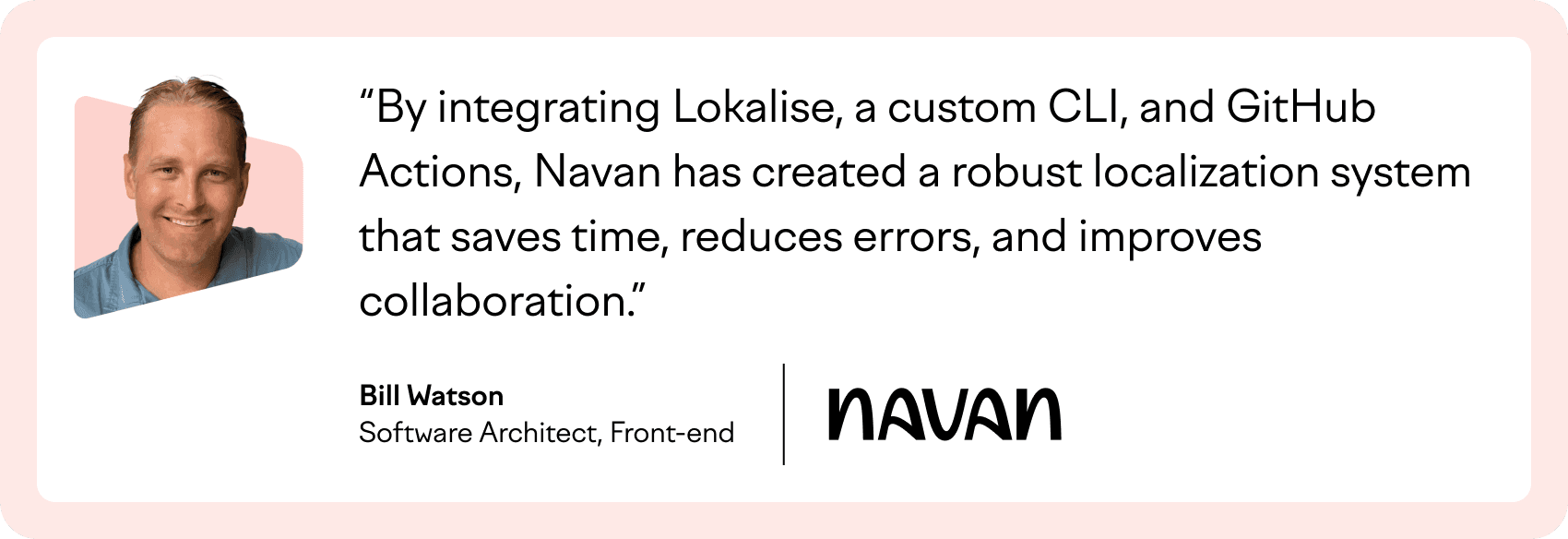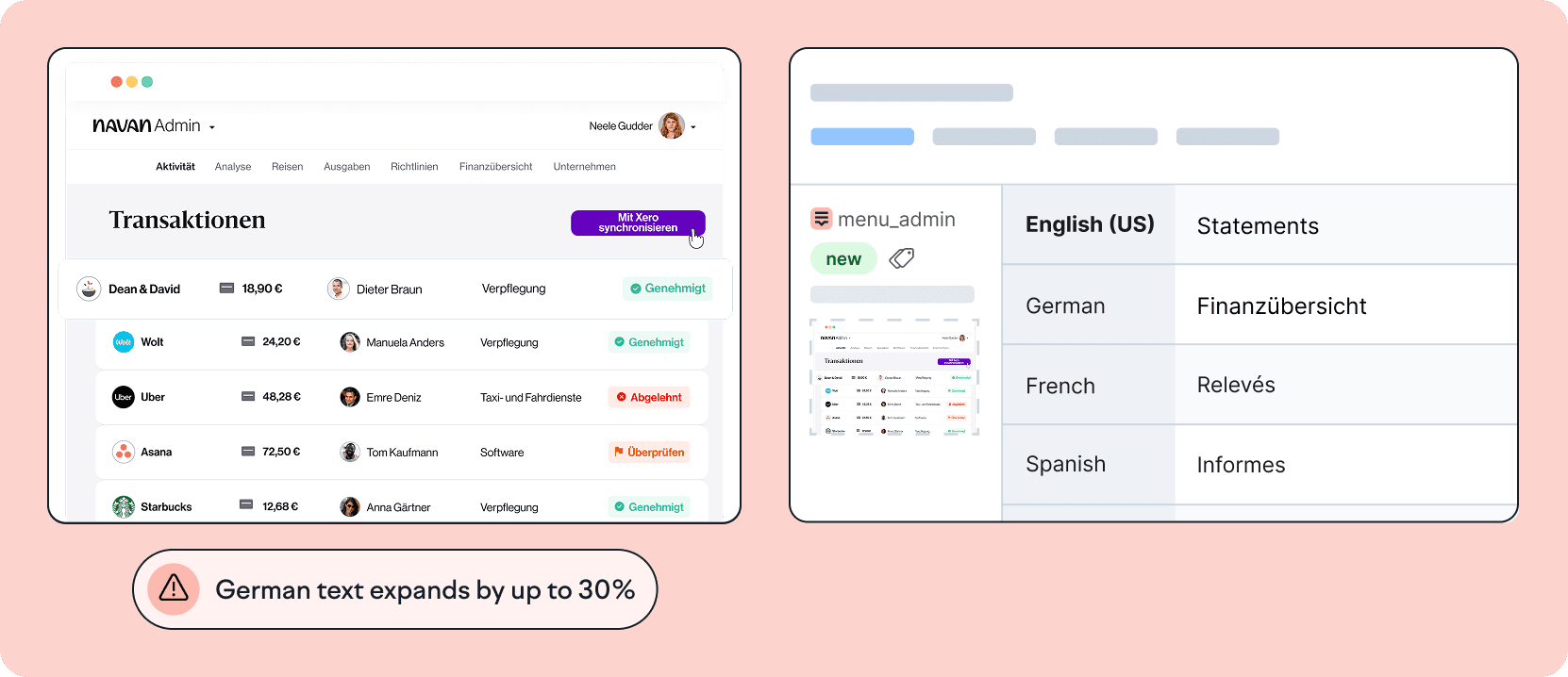How Navan reduced translation turnaround times by up to 93% and achieved 100% product localization in 9 languages
Avg. of 10k words
translated weekly
90-93% reduction
in translation turnaround times
90% ticket reduction
from internal teams flagging untranslated content
Navan 🌍 Lokalise: a summary
🧳 The requirement: A unified localization program that would be easy for developers to use and integrate
💡The solution: The team at Navan connected Lokalise to their developers’ tech stack so they could:
- Handle everything that needs translating programmatically
- Easily work with translators
- Improve collaboration between all stakeholders
🏅 The results:
- Better communication with developers for significant bug reductions
- Automated localization process that saves time and prevents delays
- Single source of truth for improved collaboration
About Navan
Navan is the all-in-one business travel and expense management platform, allowing users to easily book, view, and manage their business travel and expenses.
Challenge: Teams were without a defined centralized approach and cadence to support translations
When Paula Fernández Quesada joined Navan, there was no unified localization program in place. They were using Lokalise, but it hadn’t been set up efficiently across different engineering teams.
Developers were importing and exporting many files manually, and there was no way for other teams to know when they’d uploaded a file for translation, or for developers to know when the uploaded keys had been translated.
So, translations were a black box: developers would wait for the file to be translated or expect translations to happen automatically. After a few days, they'd reach out asking why files hadn't been translated.
That created a lot of back and forth and extended turnaround times across teams.
The person tasked with localization was in the process of testing other tools. They’d narrowed it down to two: Lokalise (their existing tool) and Smartling.
Paula had used both localization platforms in the past and understood how to get the most out of each tool.
But she wanted to put a structure in place that met the teams’ needs before jumping from tool to tool with no long-term plan.
Developers wanted a tool that would be easy to use and integrate with their tech stack. They also needed a way to automate their current manual processes.
Solution: Navan chose Lokalise for its ease of use, excellent support, and transparent pricing
Paula pushed for Navan to stick with Lokalise because she knew the platform's potential. She just needed to make sure the team was using it properly, especially to automate translation workflows and manage keys.
Apart from powerful workflow automation, Navan chose Lokalise over other localization tools for three reasons:
- Easy to use and set up. The team found that Lokalise was “fully intuitive”. They're currently looking into further unifying processes and resources with other teams within the overall Navan group.
- The culture of supporting customers. Not just customer success managers, but also the people Navan talked to through Intercom. “They're super helpful, they know exactly what to answer and take the time to look into the issues you have.”
- Visibility of the pricing model. There are no hidden costs, so you know exactly what you're paying for and you know exactly the costs for everything, which was a huge advantage for Paula in building trust.
You really notice how involved the customer support team and our CSM are. They're super helpful and very knowledgeable as well. You notice that it's good support, and you don't really see that everywhere.
Paula Fernandez Quesada,
Manager-Product Localization at Navan
Navan connected their repositories to Lokalise through different integrations and connectors, such as GitHub actions, CLI, and Lokalise API, which improved workflow efficiency and set expectations on when and how things would be imported and exported.
For example, content for the iOS and Android apps came through Lokalise once a week. So stakeholders knew that by the end of that week, things were going to be translated.
There was no back-and-forth asking why something hadn’t been translated.
The team at Navan now knows exactly when translation files are coming through, and when they will be translated.

Lokalise also helped Navan reduce time figuring out why things weren't translated.
Before, Paula was asking herself if she had forgotten to send something for translation, if keys were still being translated, or if any of the other "thousand different reasons" were blocking translations.
Now, she can pinpoint exactly where the bottleneck is. If content goes untranslated, she now knows it's only for a couple of days (instead of weeks), and even before releases happen.
Paula also set up the Slack integration to route queries to one channel, where she tags the relevant point of contact if she cannot answer the query herself.
“That has massively reduced the number of queries going directly to Developers”, says Paula.

Another feature that Paula uses inside Lokalise is Analytics. It has helped Paula show the value of a robust localization strategy and platform.
She uses it to show the Chief of Staff for EMEA Product Strategy, who in turn shares it with the EMEA CEO, how much the team has translated in how many weeks or months, how much they’ve caught up with, and how many words are left to translate—this essentially helps reduce the number of “bugs”, which were mostly for untranslated content.
Now the whole team has a better overview.
“It’s my go-to place to see how much we have left to translate, how much we’ve done in the last couple of months, and what’s pending.”
Results: A streamlined process that reduced queries to devs by over 75%, provided a customizable configuration blueprint for engineering teams, and sped up language launches to match release times
Now, localization at Navan runs a lot smoother and stakeholders work more collaboratively and efficiently.
File uploads and downloads are automated, so there’s always a constant influx of new keys. That makes the whole process easier for developers because they know they don't have to go into Lokalise to upload and download translations.
With the help of Bill Watson, Navan’s Software Architect Front-end, developers set up a system to log in using the CLI so they could do everything through GitHub actions.

Because of the automated workflow, files are translated every week into nine languages.
Content is sent for translation as soon as keys have been imported, so there’s no more waiting up to three to four weeks for content to be translated. The wait time is, on average, 2 working days.
We went from having around 1/4 of our whole product offering translated for 7 of our 9 languages to, after only 5 months, offering the full scope of our products in all 9, including our mobile apps, linguistic in-context reviews, and improvement of i18n standards for our codebase
Paula Fernández Quesada,
Manager-Product Localization at Navan
Automations have also meant Paula attending fewer online meetings with the team in Palo Alto. They’re in a different time zone, so Paula would often have to hop on late calls with engineers.
Now, communication is much simpler between Paula and the developers, “in terms of what they can expect from me and what I can expect from them.”
Collaboration has improved too, not just with developers. Translators also love Lokalise, and the team at Navan can make sure that the translators get the context that they need.
As for Paula, Lokalise has saved her up to 4-5 hours a week, meaning she can focus on personal projects.
She’s now learning to code, so she can better understand developers and how they work. That way she can create a localization process that will make her team’s processes even more efficient.
Take your products global with Lokalise
Talk to one of our experts to learn how to localize with confidence.
Case studies

Behind the scenes of localization with one of Europe’s leading digital health providers
Read more Case studies
Support
Company
Localization workflow for your web and mobile apps, games and digital content.
©2017-2025
All Rights Reserved.

